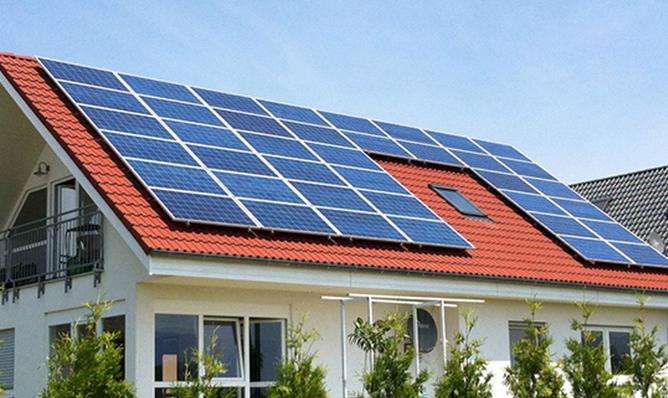It is best for solar panels to face south.
Solar panels should face the sun and get the most sunlight. The azimuth angle of the panels on common solar street lights in life is generally chosen to be in the south direction, which can optimize the power output of solar panels per unit time if the solar street lights are installed in places such as roofs. slopes, mountains and building structures. When considering restrictions on shadows, etc., you should consider how to make full use of the existing land and effective area, and try to avoid shadows generated by surrounding buildings, structures or trees.
As long as it is ±20° due south, it will not have a big impact on electricity production. If conditions permit, it should be as far as possible within 20° southwest to phermit the peak. of solar energy production will appear around noon, which will make it possible to produce more electricity in winter. When the installation area of solar panels in the south direction is not large enough, the solar panels can also be installed in the east and west directions.
Selection of the tilt angle of the solar panels:
The ideal tilt angle is to make the annual energy production of the street lighting solar panels as large as possible, so that in winter The difference in electricity production between summer and summer is as small as possible. Generally, local latitude or local latitude plus a few degrees is used as the tilt angle for local installation of solar cell module. (Generally, the tilt angle is 30 degrees in areas south of the Yangtze River and 45 degrees in areas north of the Yangtze RiverYangtze.)
Of course, if computer-aided design software can be used, the solar tilt angle optimization calculation can be carried out, it would be better to be able to take into account accounts for both, which is particularly important for high latitudes. There is a very large difference in horizontal solar radiation between winter and summer at high latitudes.
If the design is based on horizontal plane radiation parameters, the storage capacity of the battery in winter will be too large, resulting in an increase in the design capacity and investment of the battery. battery. By choosing the optimal tilt angle, the difference between winter and summer radiation on the solar panel becomes smaller and the battery capacity can also be reduced. A balance is found, which reduces the cost of the entire solar street lighting system. straighter designonnable.
The reasons why solar energy is generally placed obliquely: 1. The surface area of the water heater is limited, and the sunlight is irradiated at an angle to the ground plane. Therefore, in order to maximize the illuminated area, the solar water heater uses the Tilt installation method. 2. Solar water heaters are made of glass tubes and are most susceptible to hail. Generally, hail falls in the direction of Earth's gravity, that is, perpendicular to the ground. A water heater installed at an angle can reduce the affected area. attack, and at the same time, it can reduce the vertical impact The effect of force. 3. A simple solar water heater placed at an angle receives the most heat and has the highest water temperature.
The solar water heater is a device that uses sunlight to heat water. Solar water heaters are divided into vacuum tube solar water heaters andin flat panel solar water heaters which account for the majority of the domestic market share.
Principle of solar water heater
Solar water heaters convert solar energy into thermal energy and heat water from low temperature to high temperature to meet people's use of hot water in life and production. Solar water heaters are divided into vacuum tube solar water heaters and flat panel solar water heaters based on their structural shapes. Evacuated tube solar water heaters are the main ones, accounting for 95% of the domestic market share. Household evacuated tube solar water heaters are composed of heat collecting tubes, water storage tanks, brackets and other related accessories. The conversion of solar energy into thermal energy mainly relies on heat collecting tubes. The heat collecting tube uses theprinciple of hot water floating up and cold water going down to cause microcirculation of water to achieve the required hot water.
Classification of solar water heaters
1. Solar water heaters with glass evacuated tubes
The most. those commonly used are all-glass vacuum tube type, especially solar water heaters with auxiliary electric heating function, which use solar energy as the main source and are supplemented by electric energy, enable heating -Solar water works normally throughout the year and around the clock, and the efficiency is still relatively high when the ambient temperature is low. It is safe, energy-saving and environmentally friendly, but it is relatively bulky, the glass tube is fragile, scale is easily accumulated in the tube, and it cannot work under pressure.
2. Flat Plate Solar Water Heaters
Flat plate solar water heaters can be divided into tube plate type, wing tube type, snake tube type. , flat box type and round tube type and heat pipe type. Suitable for use in southern regions where winter does not freeze. It has good integrity, long service life, few defects, can work under pressure, is safe and reliable, has a large heat absorption surface, but has poor thermal insulation performance.
3. Ceramic Hollow Flat Plate Solar Water Heater
Ceramic solar panels are based on ordinary ceramics and have a three-dimensional vanadium-titanium black porcelain mesh. as a surface layer. Thin-walled hollow flat box solar collector. Ceramic solar panels are made of porcelain material as a whole, which is waterproofble to water, has high strength and good rigidity, does not corrode, does not age, does not fade, is non-toxic, harmless and non-radioactive. The absorption rate will not fade and provides long-term high performance. High photothermal conversion efficiency and wide range of uses.














